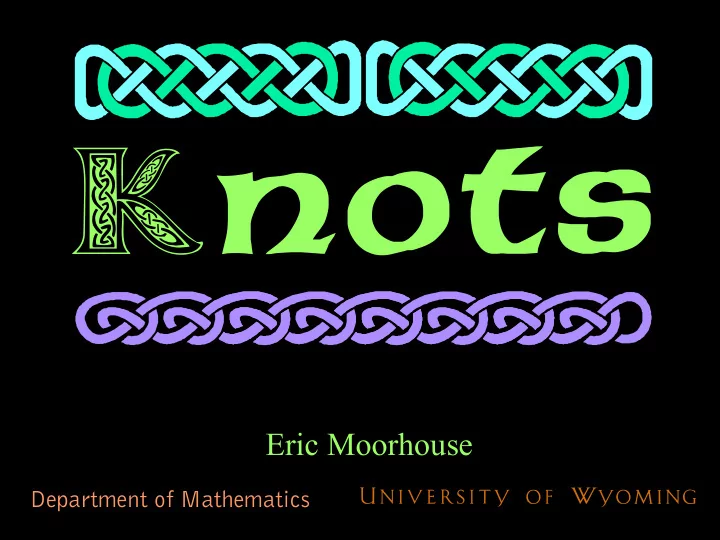

K Eric Moorhouse Department of Mathematics
Thomson modeled atoms as knots in the ether William Thomson (Lord Kelvin) 1824–1907
Bohr’s model of the atom Niels Bohr 1885–1962
I R EA L L Y T H IN K K N O T S A R E A S G O O D A D ES CR IPT IO N O F A T O M S A S I ’ V E S EEN ! James Clerk Maxwell 1831–1879
Peter Guthrie Tait Began to make a 1831 – 1901 catalog of knots…
Catalog of Knots 5 1 6 1 6 2 6 3 7 1 3 1 4 1 5 2 0 1 7 2 7 3 7 4 7 5 7 6 7 7 8 1 8 2 etc…
Unknot 0 1
= Unknot 0 1
The trefoil knot 3 1 is 3-colorable Arcs of the knot diagram ● are colored red, green and blue. All three colors must be used. At each crossing point, ● either one color or all three colors appear.
The knot 4 1 is not 3-colorable
The knot 4 1 is not 3-colorable
The knot 4 1 is not 3-colorable
The knot 4 1 is not 3-colorable
The knot 4 1 is not 3-colorable
The knot 4 1 is not 3-colorable
The knot 4 1 is not 3-colorable
This shows that 3-colorable not 3-colorable ≠ Trefoil knot 3 1 4 1
And that 3-colorable not 3-colorable ≠ Trefoil knot 3 1 Unknot 0 1
But why … not 3-colorable not 3-colorable ≠ 4 1 Unknot 0 1
James Alexander 1888–1971 1–3 x + x 2 Alexander polynomial 4 1 of the knot 4 1
a c a b d A 1– x 0 B x x A –1 0 –1 1– x B c 0 –1 1– x –1 C C 1– x 0 D d x x b D
Alexander polynomial 1–3 x + x 2 of the knot 4 1
Alexander Polynomials of Knots 1–3 x + x 2 1– x + x 2 – x 3 + x 4 2–3 x +2 x 2 1– x + x 2 1 0 1 3 1 4 1 5 1 5 2 1–3 x +3 x 2 1–3 x +5 x 2 1– x + x 2 – x 3 2–5 x +2 x 2 –3 x 3 + x 4 –3 x 3 + x 4 + x 4 – x 5 + x 6 etc… 6 2 6 3 6 1 7 1
Prime Factorization of Knots and their Alexander polynomials (1– x + x 2 )(1–3 x + x 2 ) 1–3 x + x 2 1– x + x 2 = # 3 1 4 1 3 1 # 4 1
But inequivalent knots sometimes have the same Alexander polynomial! 1 – 5 x + 12 x 2 –15 x 3 1 – 5 x + 12 x 2 –15 x 3 + 12 x 4 –5 x 5 + x 6 + 12 x 4 –5 x 5 + x 6 9 28 9 29
Found connections between von Neumann algebras and geometric topology, resulting in a new polynomial invariant for knots. Vaughn Jones (1952– ) Awar ded t he Fi el ds M edal i n 1990
Jones Polynomials of Knots – x -6 + x -5 – x -4 – x -7 + x -6 – x -5 – x -4 + x -3 + x -1 x -2 – x -1 + 1 + 2 x -3 – x -2 + x -1 – x + x 2 + x -4 + x -2 1 0 1 3 1 4 1 5 1 5 2 x -5 – 2 x -4 + 2 x -3 – x -3 + 2 x -2 – x -10 + x -9 x -4 – x -3 + x -2 – 2 x -2 + 2 x – 2 x -1 + 3 – x -8 + x -7 – 2 x -1 + 2– x + x 2 – 1 + x – 2 x + 2 x 2 – x 3 – x -6 + x -5 + x 3 etc… 6 2 6 3 6 1 7 1
These inequivalent knots have different Jones polynomials! – x -6 + 3 x -5 – 6 x -4 – x -2 + 3 x -1 – 5 + 8 x -3 – 8 x -2 + 9 x -1 – 7 + 8 x – 8 x 2 + 9 x 3 – 8 x 4 + 5 x – 3 x 2 + x 3 + 5 x 5 – 3 x 6 + x 7 9 28 9 29
There do exist inequivalent knots with the same Jones polynomial. It is not known whether the unknot is the only knot with Jones polynomial = 1. Unknot 0 1 Jones polynomial = 1
Knots Links vs.
UW conducts intensive research into knots using the latest technology…
www.pims.math.ca/KnotPlot/ Knotplot.lnk
Recommend
More recommend